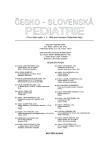Vascular Anomalies in Children – a New Classification System, Natural History and Treatment
Vaskulární anomálie v dětském věku – nová klasifikace, vývoj a možnosti léčby
Vaskulární léze jsou v kojeneckém a dětském věku běžné, ale jejich klasifikace není jednotná. V roce 1996 Mezinárodní společnost pro studium vaskulárních anomálií schválila jejich nové roztřídění, které bylo odvozené ze schématu původně navrženého Mullikenem a Glowackim. Jejich záměrem bylo zavést společný jazyk pro lékařské specialisty rozdílných oborů, kteří pečují o děti s tímto postižením. Jsou vymezeny dvě skupiny vaskulárních anomálií: vaskulární tumory (z nichž jsou nejčastější kojenecké hemangiomy) a vaskulární malformace. Klasifikace je založena na rozdílech v buněčné kinetice a vývoji těchto lézí. Autorky sumarizují klasifikaci, patogenezi, management, prognózu a léčbu vaskulárních anomálií.
Klíčová slova:
vaskulární anomálie, klasifikace, patogeneze, management, prognóza, léčba
Authors:
J. Šimková 1; M. Ganevová 2; J. Radvanská 2; Š. Čapková 1
Authors‘ workplace:
Dermatologická ambulance, Dětská poliklinika, FN Motol, Praha
primář MUDr. P. Tláskal, CSc.
1; Klinika dětské hematologie a onkologie 2. LF UK a FN Motol, Praha
přednosta prof. MUDr. J. Starý, DrSc.
2
Published in:
Čes-slov Pediat 2005; 60 (1): 20-26.
Category:
Postgraduate Education
Overview
Vascular lesions are common in infants and children, but their precise classification can be confusing. In 1996, the International Society for the Study of Vascular Anomalies (ISSVA) approved a classification system modified from the scheme originally proposed by Mulliken and Glowacki. Their aim was to establish a common language for the many different medical specialists involved in the management of these lesions. Two groups of vascular anomalies are delineated: vascular tumors (of which hemangioma of infancy is the most common) and vascular malformations.
The classification was based on differences in the cellular kinetics and natural history of these lesions. The authors summarize the classification, pathogenesis, management, treatment and prognosis of vascular anomalies.
Key words:
vascular anomalies, classification, pathogenesis, management, prognosis, therapy
Labels
Neonatology Paediatrics General practitioner for children and adolescentsArticle was published in
Czech-Slovak Pediatrics

2005 Issue 1
- What Effect Can Be Expected from Limosilactobacillus reuteri in Mucositis and Peri-Implantitis?
- The Importance of Limosilactobacillus reuteri in Administration to Diabetics with Gingivitis
Most read in this issue
- Sad Facies, Spinal Malsegmentation, Progressive Vicious Kyphoscoliosis, Multiple Wormian Bones, Basilar Impression – A Novel Syndrome. Report of Two Sisters
- Genetic Polymorphisms of UGT 1A1*28 in the TATA-box Promoter Region of Bilirubin Uridinediphosphate-glucuronosyltransferase Gene in Children with Gilbert’s Syndrome
- Vascular Anomalies in Children – a New Classification System, Natural History and Treatment
- Unique Pattern Syndrome of Distinctive Facies, Short Stature, Kyphoscoliosis, Craniosynostosis, Hyperlaxity and Dyslexia
